
The Lamniformes are an order of sharks commonly known as mackerel sharks. It includes some of the most familiar species of sharks, such as the great white as well as less familiar ones, such as the goblin shark and megamouth shark.

The Lamnidae are the family of mackerel sharks known as white sharks. They are large, fast-swimming predatory fish found in oceans worldwide, though they prefer environments with colder water. The name of the family is formed from the Greek word lamna, which means "fish of prey", and was derived from the Greek legendary creature, the Lamia.

Caturus is an extinct genus of predatory marine fishes in the family Caturidae in the order Amiiformes, related to modern bowfin. It has been suggested that the genus is non-monophyletic with respect to other caturid genera.

Palaeoniscum is an extinct genus of ray-finned fish from the Permian period (Guadalupian-Lopingian) of England, Germany, Turkey, North America and Greenland, and possibly other regions. The genus was named Palaeoniscum in 1818 by Henri Marie Ducrotay de Blainville, but was later misspelled as Palaeoniscus by Blainville and other authors. Palaeoniscum belongs to the family Palaeoniscidae.

Myliobatis is a genus of eagle rays in the family Myliobatidae.

The Palaeonisciformes, commonly known as "palaeoniscoids" are an extinct grouping of primitive ray-finned fish (Actinopterygii), spanning from the Silurian/Devonian to the Cretaceous. They are generally considered paraphyletic, but their exact relationships to living ray-finned fish are uncertain. While some and perhaps most palaeoniscoids likely belong to the stem-group of Actinopteryii, it has been suggested that some may belong to the crown group, with some of these possibly related to Cladistia and/or Chondrostei. Many palaeoniscoids share a conservative body shape and a similar arrangement of skull bones, though paleoniscoids as a whole exhibit considerable diversity in body shape.

Carcharias is a genus of mackerel sharks belonging to the family Odontaspididae. Once bearing many prehistoric species, all have gone extinct with the exception of the critically endangered sand tiger shark.
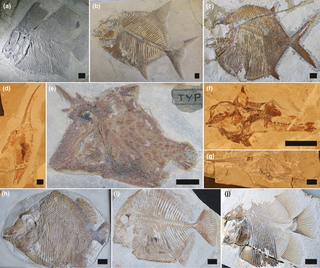
Pycnodontiformes is an extinct order of primarily marine bony fish. The group first appeared during the Late Triassic and disappeared during the Eocene. The group has been found in rock formations in Africa, Asia, Europe, North and South America.

Eoophyla is a genus of moths of the family Crambidae. It was erected by Charles Swinhoe in 1900.
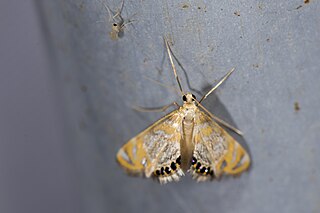
Nymphicula is a genus of moths of the family Crambidae.

Palaeoniscidae is an extinct family of "palaeoniscoid" ray-finned fishes (Actinopterygii). The family includes the genus Palaeoniscum and potentially other Palaeozoic and Mesozoic early actinopterygian genera. The name is derived from the Ancient Greek words παλαιός and ὀνίσκος.

The redtail surfperch is a marine fish that inhabits the near-shore and estuarine waters of North American Pacific coasts.

Amphistichus is a genus of surfperches native to the eastern Pacific Ocean.
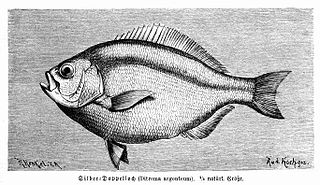
Hyperprosopon is a genus of surfperches native to the eastern Pacific Ocean.
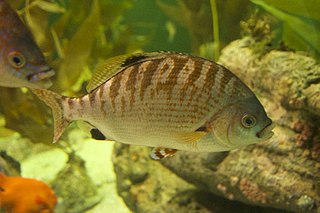
The rainbow surfperch, also known as rainbow seaperch, or bugara, is a species of surfperch found along the Pacific coast of North America from Cape Mendocino, California to northern Baja California, Mexico. This species prefers rocky shores over sandy ones, and is never found in the surf, preferring the edges of kelp forests down to depths of about 40 metres (130 ft). This species grows to a length of 30 centimetres (12 in) TL. This species is the only known member of its genus. The specific name honours Thomas Cary (1824-1888), a business man and amateur naturalist who was also the brother-in-law of Louis Agassiz who procured specimens that confirmed that this species was viviparous.

Phanerodon is a genus of surfperches native to the eastern Pacific Ocean.
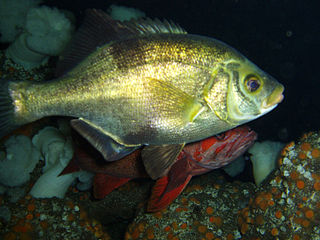
Rhacochilus is a genus of surfperches native to the eastern Pacific Ocean.

Embiotoca jacksoni, commonly known as the black surfperch, is a species of surfperches native to shallow coastal areas of the eastern Pacific. Other common names of the species include black perch and butterlips. They are usually a dark reddish brown to tan in color, often also with vertical dark bars across their body. They are commercially important food and game fish.

Embiotoca lateralis, commonly known as the striped surfperch or striped seaperch, is a species of surfperch native to the north-eastern Pacific Ocean.
Sea perch, sea-perch or seaperch are the common names of various fishes, including:



















